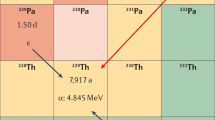Abstract
Atomic nuclei with certain combinations of proton and neutron numbers can adopt reflection-asymmetric or octupole-deformed shapes at low excitation energy. These nuclei present a promising avenue in the search for a permanent atomic electric dipole moment—the existence of which has implications for physics beyond the Standard Model of particle physics. Theoretical studies have suggested that certain thorium isotopes may have large octupole deformation. However, due to experimental challenges, the extent of the octupole collectivity in the low-energy states in these thorium nuclei has not yet been demonstrated. Here, we report measurements of the lifetimes of low-energy states in 228Th (Z = 90) with a direct electronic fast-timing technique, the mirror symmetric centroid difference method. From lifetime measurements of the low-lying Jπ = 1− and Jπ = 3− states, the E1 transition probability rates and the intrinsic dipole moment are determined. The results are in agreement with those of previous theoretical calculations, allowing us to estimate the extent of the octupole deformation of 228Th. This study indicates that the nuclei 229Th and 229Pa (Z = 91) may be good candidates for the search for a permanent atomic electric dipole moment.



Similar content being viewed by others
Data availability
The data that support the plots within this paper and other findings of this study are available from the corresponding author upon reasonable request.
Code availability
The code used to process the data presented in this paper is available from the corresponding author upon reasonable request.
References
Bohr, A. The coupling of nuclear surface oscillations to the motion of individual nucleons. Dan. Mat. Fys. Medd. 26, No. 14 (1952).
Bohr, A. & Mottelson, B. R. Collective and individual-particle aspects of nuclear structure. Dan. Mat. Fys. Medd. 27, No. 16 (1953).
Butler, P. A. & Nazarewicz, W. Intrinsic dipole moments in reflection-asymmetric nuclei. Nucl. Phys. A 533, 249–268 (1991).
Regan, B. C., Commins, E. D., Schmidt, C. J. & Demille, D. New limit on the electron electric dipole moment. Phys. Rev. Lett. 88, 071805 (2002).
Hudson, J. J. et al. Improved measurement of the shape of the electron. Nature 473, 493–496 (2011).
Baron, J. et al. Order of magnitude smaller limit on the electric dipole moment of the electron. Science 343, 269–272 (2014).
Cairncross, W. B. et al. Precision measurement of the electron’s electric dipole moment using trapped molecular ions. Phys. Rev. Lett. 119, 153001 (2017).
ACME Collaboration. Improved limit on the electric dipole moment of the electron. Nature 562, 355–360 (2018).
Agbemava, S. E., Afanasjev, A. V. & Ring, P. Octupole deformation in the ground states of even–even nuclei: a global analysis within the covariant density functional theory. Phys. Rev. C 93, 044304 (2016).
Schiff, L. I. Measurability of nuclear electric dipole moments. Phys. Rev. 132, 2194–2200 (1963).
Sushkov, O., Flambaum, V. & Khriplovich, I. Possibility of investigating P- and T-odd nuclear forces in atomic and molecular experiments. Zh. Eksp. Teor. Fiz. 87, 1521–1540 (1984).
Flambaum, V. V., Khriplovich, I. B. & Sushkov, O. P. Limit on the constant of T-nonconserving nucleon-nucleon interaction. Phys. Lett. B 162, 213–216 (1985).
Auerbach, N., Flambaum, V. V. & Spevak, V. Collective T- and P-odd electromagnetic moments in nuclei with octupole deformations. Phys. Rev. Lett. 76, 4316–4319 (1996).
Spevak, V., Auerbach, N. & Flambaum, V. V. Enhanced T-odd, P-odd electromagnetic moments in reflection asymmetric nuclei. Phys. Rev. C 56, 1357–1369 (1997).
Ellis, J., Lee, J. S. & Pilaftsis, A. Maximal electric dipole moments of nuclei with enhanced Schiff moments. J. High Energy Phys. 2011, 45 (2011).
Chasman, R. R. Incipient octupole deformation and parity doublets in the odd mass light actinides. Phys. Lett. B 96, 7–10 (1980).
Ahmad, I., Gindler, J. E., Betts, R. R., Chasman, R. R. & Friedman, A. M. Possible ground-state octupole deformation in 229Pa. Phys. Rev. Lett. 49, 1758–1761 (1982).
Grafen, V. et al. Does a 5/2+-5/2− ground-state parity doublet exist in 229Pa? Phys. Rev. C 44, R1728–R1731 (1991).
Lösch, A. et al. The low-lying levels in 229Pa and parity doublets. Z. Phys. A 348, 235–235 (1994).
Ahmad, I., Chasman, R. R., Greene, J. P., Kondev, F. G. & Zhu, S. Electron capture decay of 58-min \({}_{92}^{229}{\mathrm{U}}\)and levels in \({}_{92}^{229}{\mathrm{U}}\). Phys. Rev. C 92, 024313 (2015).
Flambaum, V. V. Enhanced nuclear Schiff moment and time-reversal violation in 229Th-containing molecules. Phys. Rev. C 99, 035501 (2019).
Stephens, F., Asaro, F. & Perlman, I. Low-lying 1− states in even–even nuclei. Phys. Rev. 96, 1568–1572 (1954).
Stephens, F. S., Asaro, F. & Perlman, I. Radiations from 1− states in even–even nuclei. Phys. Rev. 100, 1543–1545 (1955).
Robledo, L. M. & Butler, P. A. Quadrupole-octupole coupling in the light actinides. Phys. Rev. C 88, 051302 (2013).
Gaffney, L. P. et al. Studies of pear-shaped nuclei using accelerated radioactive beams. Nature 497, 199–204 (2013).
Wollersheim, H. J. et al. Coulomb excitation of 226Ra. Nucl. Phys. A 556, 261–280 (1993).
Egido, J. L. & Robledo, L. M. Microscopic study of the octupole degree of freedom in the radium and thorium isotopes with Gogny forces. Nucl. Phys. A 494, 85–101 (1989).
Butler, P. A. & Nazarewicz, W. Intrinsic reflection asymmetry in atomic nuclei. Rev. Mod. Phys. 68, 349–421 (1996).
Ansari, S. et al. Experimental study of the lifetime and phase transition in neutron-rich 98,100,102Zr. Phys. Rev. C 96, 054323 (2017).
Martin, M. Nuclear data sheets for A = 208. Nucl. Data Sheets 108, 1583–1806 (2007).
Ton, H., Beens, W., Roodbergen, S. & Blok, J. Lifetimes of 2+ and 4+ rotational states in heavy doubly even nuclei. Nucl. Phys. A 155, 235–244 (1970).
Weber, T., Gröger, J., Günther, C. & deBoer, J. Study of the first-excited K π=0+ and 2+ bands in 228Th in the 226Ra(α,2n) reaction. Eur. Phys. J. A 1, 39–44 (1998).
Alaga, G., Alder, K., Bohr, A. & Mottelson, B. R. Intensity rules for beta and gamma transitions to nuclear rotational states. Dan. Mat. Fys. Medd. 29, No. 9 (1955).
Schüler, P. et al. High-spin states in 224,226,228Th and the systematics of octupole effects in even Th isotopes. Phys. Lett. B 174, 241–245 (1986).
Ackermann, B. et al. Collective E1 transitions in even-A Ra, Th, and U nuclei. Nucl. Phys. A 559, 61–82 (1993).
Leander, G. A. & Chen, Y. S. Reflection-asymmetric rotor model of odd A~219-229 nuclei. Phys. Rev. C 37, 2744–2778 (1988).
Dobaczewski, J., Engel, J., Kortelainen, M. & Becker, P. Correlating Schiff moments in the light actinides with octupole moments. Phys. Rev. Lett. 121, 232501 (2018).
Parker, R. H. et al. First measurement of the atomic electric dipole moment of 225Ra. Phys. Rev. Lett. 114, 233002 (2015).
Bishof, M. et al. Improved limit on the 225Ra electric dipole moment. Phys. Rev. C 94, 025501 (2016).
Abusaleem, K. Nuclear data sheets for A=228. Nucl. Data Sheets 116, 163–262 (2014).
Brun, R. & Rademakers, F. ROOT—an object oriented data analysis framework. Nucl. Instrum. Methods Phys. Res. A 389, 81–86 (1997).
Régis, J. M., Pascovici, G., Jolie, J. & Rudigier, M. The mirror symmetric centroid difference method for picosecond lifetime measurements via γ-γ coincidences using very fast LaBr3(Ce) scintillator detectors. Nucl. Instrum. Methods Phys. Res. A 622, 83–92 (2010).
Kocheva, D. et al. Low collectivity of the \({2}_{1}^ {+}\) state of 212Po. Phys. Rev. C 96, 044305 (2017).
Acknowledgements
We acknowledge useful discussions with L. Robledo, who was the recipient of a SUPA Distinguished Visitor grant awarded to the University of the West of Scotland. Financial support for this work has been provided by the Scottish Funding Council (SFC) and the UK Science and Technology Facilities Council (STFC). We acknowledge the support of the UK EPSRC (grant nos EP/J018171/1, EP/J500094/1 and EP/N028694/1), the EC’s LASERLAB-EUROPE (grant no. 654148), EuCARD-2 (grant no. 312453), EuPRAXIA (grant no. 653782), ARIES (grant no. 730871) and the Extreme Light Infrastructure (ELI) European Project.
Author information
Authors and Affiliations
Contributions
D.O’D. conceived the investigation; M.M.R.C., D.O’D. and G.B. set up the instrumentation; M.M.R.C., D.O’D., G.B. and P.S. performed the data analysis; M.M.R.C., D.O’D. and M.S. interpreted the results; D.O’D., M.B., D.A.J., B.S.N.S., M.S., P.S. and J.F.S. contributed to writing the manuscript.
Corresponding author
Ethics declarations
Competing interests
The authors declare no competing interests.
Additional information
Publisher’s note Springer Nature remains neutral with regard to jurisdictional claims in published maps and institutional affiliations.
Extended data
Extended Data Fig. 1 Prompt response function.
The prompt response differences (PRD) of the fast-timing apparatus. The top panel shows the \(\gamma-\gamma\) time-walk dependence with \(\gamma\) -ray energy of the fast-timing apparatus. Data points correspond to transitions depopulating prompt states in \({}^{152}\) Sm and \({}^{152}\) Gd following the \(\beta\) -decay of \(^{152}\) Eu. Error bars, representing two standard deviations, are smaller than the symbols for the data points. The function fitted to the data has the form \(\text{PRD}(E_\gamma) = \frac{a}{\sqrt{E_\gamma+b}}+c{E_\gamma}^2+dE_\gamma+e\) where \(E_\gamma\) is the \(\gamma\) -ray energy and a,b,c,d and e are parameters to be determined. The bottom panel shows the differences between the data and the fitted prompt response function with the dashed lines showing the mean uncertainty of the fit corresponding to two standard deviations.
Rights and permissions
About this article
Cite this article
Chishti, M.M.R., O’Donnell, D., Battaglia, G. et al. Direct measurement of the intrinsic electric dipole moment in pear-shaped thorium-228. Nat. Phys. 16, 853–856 (2020). https://doi.org/10.1038/s41567-020-0899-4
Received:
Accepted:
Published:
Issue Date:
DOI: https://doi.org/10.1038/s41567-020-0899-4
- Springer Nature Limited




